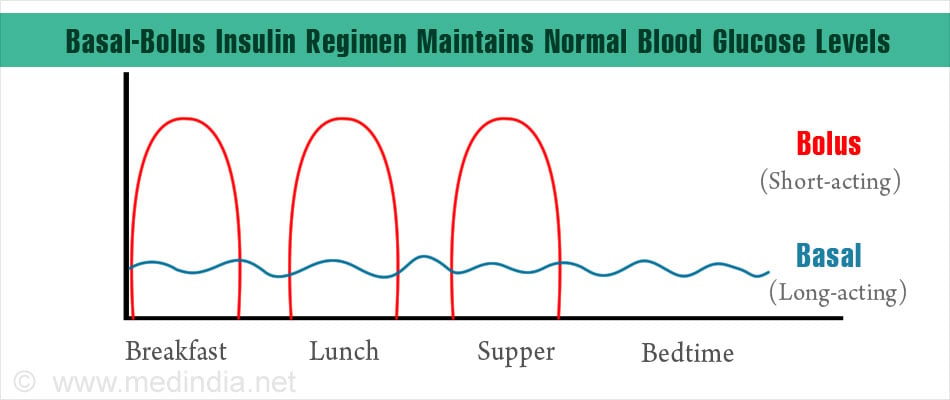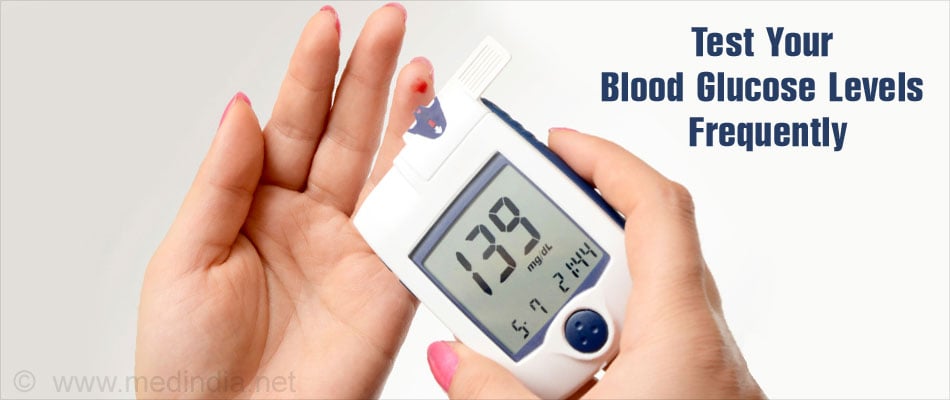- Basal Bolus – Basal Bolus Injection Regimen - (http://www.diabetes.co.uk/insulin/basal-bolus.html)
- Comparison between a basal-bolus and a premixed insulin regimen in individuals with type 2 diabetes-results of the GINGER study - (http://www.ncbi.nlm.nih.gov/pubmed/20092584)
Basal-bolus Insulin Therapy
Understanding the role of insulin is important to understand the underlying problem in diabetes. In a person without diabetes, insulin is normally produced by the pancreas in optimal levels and is present in the whole body throughout. The pancreas provides basal and bolus insulin to the body. Insulin is produced according to the food consumed, activity levels, stress periods and illnesses. The basal-bolus system in healthy individual works in such a way that the blood glucose level is maintained within the normal range at all times (even with consumption of sugar and glucose).
A person with diabetes and on insulin therapy requires the blood glucose level to be maintained at normal levels, without unnecessary spikes or lows. For a person with diabetes and on insulin requiring stringent maintenance, the best method is the basal-bolus insulin therapy. This method of diabetes management tries to replicate the role of insulin in a normal body.

A long-lasting or basal insulin is given as the background insulin to manage blood glucose levels between meals and when sleeping. This basal dosage is combined with short-acting boluses to keep the blood glucose in check after meals. The basal insulin covers 50% of the body’s insulin requirement while the boluses cover the other 50%. Types of basal insulin include Glargine (Lantus), Detemir (Levemir) or the most recent insulin Degludec (Tresiba).
The main aim of going on a basal-bolus insulin regimen is to keep the blood sugar range as healthy as possible. It is important to work out an optimal basal-bolus dosage to take full advantage of this regimen. The dosage is usually titrated according to age, weight, insulin resistance, other co-morbidities, calorific intake and exercise regimen.
Insulin and Its Role in Diabetes
In a person without diabetes, pancreas produces insulin at optimal levels and is present in the whole body. The pancreas provides basal and bolus insulin to the body.
- Basal insulin is the background insulin which is required by the body to control the blood glucose levels even when no food is consumed or fasting. It helps control blood glucose within the normal range even when you are not eating and the body releases glucose into the blood stream. Basal insulin works even while the body is in the resting/sleep state.
- Bolus insulin is released when the body consumes food to adjust the blood glucose levels.
In a person without diabetes, the pancreas automatically produces the exact amount of basal and bolus insulin to keep the blood glucose levels normal. The basal-bolus system in a healthy individual work in such a way that the blood glucose level is maintained within the normal range at all times (even with consumption of sugar and glucose).
Basal-bolus Insulin Therapy for Diabetes
For a person with diabetes and on insulin requiring stringent maintenance, the best method is the basal-bolus insulin therapy. This method of diabetes management tries to replicate the role of insulin in a normal body.
Bolus insulin is usually taken before the main meals of the day which is breakfast, lunch and dinner. Bolus dosages are usually fast-acting like Actrapid or Humulin S. A bolus dosage can also be taken if the blood glucose is high to rapidly bring it down. Temporary high glucose has many causes, including:
- Infection
- Critical illness
- Excess consumption of carbohydrates
- Steroids
- Incorrect insulin dosage or missed dosage
- Psychological stress

Basal insulin is taken just once a day. Most diabetologists and endocrinologists recommend the basal dose to be taken before bedtime for it to work optimally.
The Basal-bolus Insulin Regimen
A basal-bolus regimen can prevent long-term complications associated with diabetes. You are advised to go on a basal-bolus regimen when:
- Your fasting blood glucose is high in the morning
- You have hypoglycemic or low sugar episodes at night
- You require more flexibility regarding meal times and snacking
- You work in shifts
- You plan to travel across time zones
However, the basal-bolus insulin therapy involves four shots a day. Children, especially may not be so compliant with four injections. This regimen is the current best practice to maintain the normal blood glucose levels without the unwarranted sudden highs and lows associated with the insulin therapy.

The basal insulin (like Degludec) works over 48 hours and maintains an optimal blood glucose level if taken in the right dosage. Basal insulin’s also prevent too many hypoglycemic episodes.
Bolus doses must be calculated very carefully to match your meal plans and intake of carbohydrates and sugars.
Calculating the Optimal Basal-bolus Dosage
- Remember that insulin is titrated at 0.3-0.5 units/kg. So if your weight is 50 kg and you are an adult, then your total insulin dosage per day is 0.5 units x 50 kg = 25 units of insulin per day
- Nearly, 50% of your total insulin dosage should be covered by the basal insulin. So 50% of 25 is 12.5,. approximate this to 12. This should be your basal dosage.
- Almost, 50% of your total insulin dosage should be covered by the bolus insulin. So another 12.5 is your total bolus dosage per day. This should be broken up into three doses to cover breakfast, lunch and dinner. However, be cautious as this dosage should vary depending on your prandial blood glucose levels and your intake of carbohydrates at each meal. If you know you are going in for extra carbohydrates or maybe a sweet, calculate the dosage according to the food portion. For example, 2-3 extra units for one small cup of ice- cream.
- When beginning your basal-bolus regimen, you are advised to test your blood glucose levels at least four times a day, initially for about 3-4 days until you are able to titrate the right dosage. Test your blood sugar:
- When you wake up, first thing in the morning (before breakfast and before consuming anything else), so you get an idea of how to adjust the bolus.
- Before lunch
- Before dinner
- Post-prandial (2 hours after dinner), so you can adjust your basal dosage.

- Do not suddenly titrate your basal dosage to a higher number. A daily increase of one unit is recommended until you reach your target blood glucose levels.
- Also, do not suddenly increase the number of bolus units without testing your blood glucose level.
- Consult your doctor if you experience too many lows or you cannot achieve your target blood glucose levels.
- Remember, each person reacts differently to insulin and the pharmacodynamics (absorption and distribution of insulin) varies between individuals. Do not ask other patients for help in titrating your dosage. Do it yourself with the help of your doctor.
- Avoid using your insulin therapy with any other oral medications without consulting your doctor.






